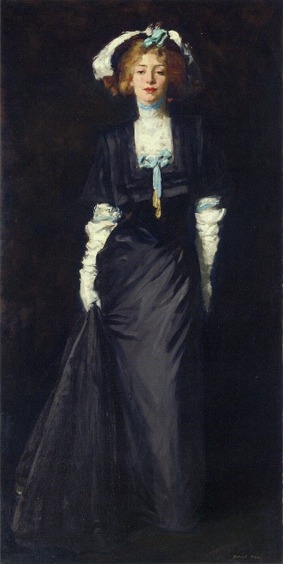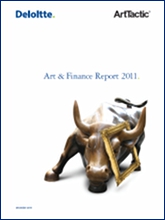As the art world must know, Alice Walton has become a punching bag for people who are really bashing Wal-Mart, largely for the wages it pays its employees and the benefits it does or does not provide. Another strain of criticism pokes at her for spending money on an art museum. Jeff Goldberg, writing for Bloomberg, recently called the Crystal Bridges Museum of Art “a moral tragedy” and “a compelling symbol of the chasm between the richest Americans and everyone else.”
 As if art were of no use or inspiration to anyone but “the rich.”
As if art were of no use or inspiration to anyone but “the rich.”
I initially tried to ignore this — except in the first paragraph of my review of Crystal Bridges, in which I said the wages link was “a confusion of apples and oranges if ever there was one.” (In my review, I savor the Robert Henri portrait, of Jessica Penn, at left, and I thought I’d show it to RCA readers.)
But Goldberg has now taken as second gun to Walton and Cystal Bridges. (Read Goldberg, if you must, here and here.)
This strikes me as a case of nothing succeeding like success and excess. Goldberg received a lot of attention for the first column, after all.
Fortunately, Ira Stoll, the former managing editor of the New York Sun — which you will recall had some pretty wonderful cultural stories — has fired back. Stoll has a website called Future of Capitalism, and yesterday he began a post saying “Remind me if I ever get rich not to start an art museum. It seems to be just an invitation for attacks from the press.”
Stoll then lists eight points in Walton’s defense, the most pertinent of which are these:
Why focus solely on her at the expense of many other rich people who fund charities in which they are interested while making money in low-wage, low health-insurance businesses? Joan Kroc, whose fortune comes from McDonald’s, gave $200 million to National Public Radio. McDonald’s treats its workers about the same as Walmart, but I haven’t seen Jeff Goldberg agitating about the moral blight of Morning Edition. Jeff Goldberg also complains about the aesthetics of Walmart stores, but they look pretty much the same as a Home Depot, a Staples, a Lowe’s, or any other big-box store. Why single out Walmart?
And:
If Alice Walton decided voluntarily to pay Walmart workers higher wages and health benefits out of her share of the Walmart profits, it would probably be difficult to structure that without also adversely affecting the returns of the other shareholders. (I suppose one could establish a separate class of stock, but it’s hard to see the rationale for giving the family that founded and built the company a class of stock that carried a lower rate of return than that available to the general public or new shareholders.) Giving all the shareholders a newly lowered rate of return would increase Walmart’s cost of capital, making it harder for the company to compete with new competitors. Stores might have to close, and instead of low-wage, low-insurance jobs, there might be no jobs at all. And the existing shareholders, who bought their shares expecting the company would pay a market wage rather than the newly generous Goldberg above-market wage, would see the value of their shares drop. Since lots of those existing shares are held by middle-class or lower-middle class Americans through mutual funds or union or government pension funds, you’d wind up hurting some of the same people you are trying to help.
I suppose some “art-lovers” are still (inanely) angry with Walton for trying to buy good picture, “taking them way” from East coast cities.
But Goldberg is really attacking the foundation on which almost all American art museums are built, and it’s about time people start recognizing that — and speaking up in her defense.
Photo Credit: Courtesy of Crystal Bridges

 Tomorrow is a big day for the Metropolitan Museum:*
Tomorrow is a big day for the Metropolitan Museum:*  But don’t think that this show comes mainly from the Met collection; there many, many loans from many European collections, including a lot from Germany — the exhibit was co-organized and shown previously at the
But don’t think that this show comes mainly from the Met collection; there many, many loans from many European collections, including a lot from Germany — the exhibit was co-organized and shown previously at the  That’s his Filippo Maria Visconti drawing in charcoal (also from the Louvre) and what Christiansen says is a rare painting by him, Leonello d’Este, from the Accademia Carrara, Commune of Bergamo, at right (sorry he faces the margin).
That’s his Filippo Maria Visconti drawing in charcoal (also from the Louvre) and what Christiansen says is a rare painting by him, Leonello d’Este, from the Accademia Carrara, Commune of Bergamo, at right (sorry he faces the margin).  The 40-year-old museum, which ran into expansion problems, is about to be dissolved,
The 40-year-old museum, which ran into expansion problems, is about to be dissolved,  I shouldn’t have been surprised, I guess — not in an age when, according to an
I shouldn’t have been surprised, I guess — not in an age when, according to an For example, while the exact same percentage of advisors and collectors said that “Investment returns” were important or very important — 48.8 percent — art advisors overestimated by a mile the “social value” and art’s function as an “inflation hedge,” and they underestimated the “emotional value” and the “tax” and “portability” values of art. Are art collectors planning to flee something? 23.1% said portability was important or very important in buying art.
For example, while the exact same percentage of advisors and collectors said that “Investment returns” were important or very important — 48.8 percent — art advisors overestimated by a mile the “social value” and art’s function as an “inflation hedge,” and they underestimated the “emotional value” and the “tax” and “portability” values of art. Are art collectors planning to flee something? 23.1% said portability was important or very important in buying art.